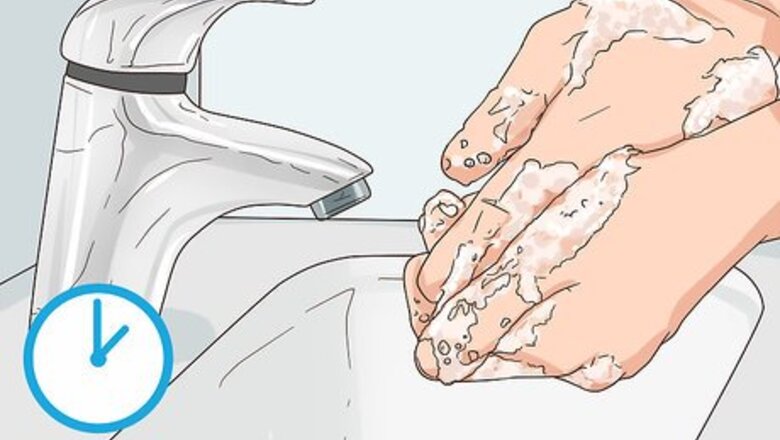
views
- Wash your hands frequently with soap and water when your irrigate a Foley catheter.
- Fill a clean syringe with 60cc of saline solution. To keep it sterile, place a tip cover on end of the syringe.
- Draw out any leftover urine from the catheter with an empty syringe and flush it out with the saline syringe.
- Wipe down the drainage tubing and catheter connection site with an alcohol wipe for 15 seconds.
Preparing the Flush Solution
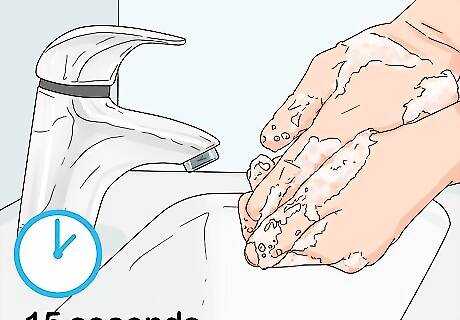
Wash your hands with soap and water for at least 15 seconds. When finished, dry off with clean paper towels. If necessary, alcohol hand sanitizer or towelettes may be used instead. Though not always necessary for home irrigation, you can put on disposable latex gloves for extra safety.
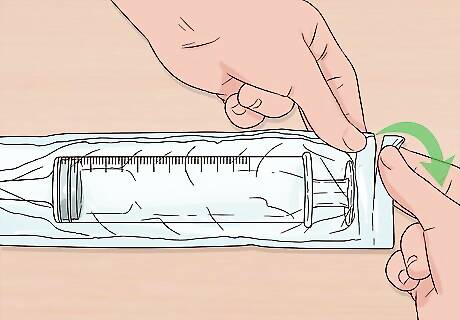
Open a new catheter tip syringe. To prevent infection, only use an unopened, sterile catheter tip syringe unless directed otherwise by your clinician. To make sure that the syringe remains sterile, do not allow the tip of the syringe to touch your skin or any other object. You'll need to use a 60cc catheter-tipped syringe for this. It may also be called a Toomey syringe. Catheter tip syringes can be purchased at most medical supply stores, drug stores, and supermarkets. They are typically sold in multi-syringe bundles for less than $1 per individual unit.
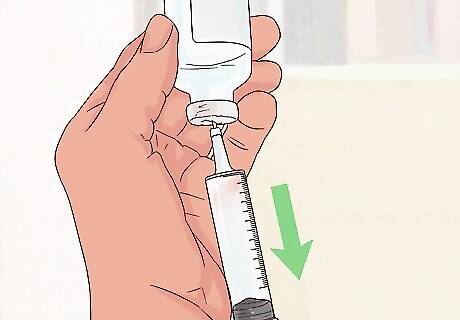
Draw saline into the syringe. Place the tip of your syringe into a bottle of normal saline solution. Then, pull back on the plunger of the syringe. Continue pulling the plunger until you have filled the syringe with the amount of saline prescribed by your doctor, typically around 60cc. Look for saline solutions at most medical supply and drug stores. They typically cost between $4 and $9 per bottle. If you can't afford saline solution, use an unopened bottle of water instead. You can also boil tap water, then use it after it's cooled. Do not use homemade saline solutions since they will increase your chances of infection. While handling the bottle of saline solution, you should only touch the outside of the container. Do not get your fingers on the top or inside of the bottle.
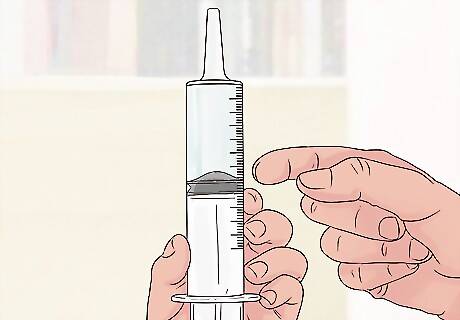
Tap the syringe to remove any air bubbles. Remove the syringe from the saline bottle and hold it vertically. Then, tap on the barrel with your knuckles to loosen any air bubbles. Place the syringe back into the bottle, then carefully push the plunger to get rid of the trapped air. If necessary, pull the plunger back again to replace any lost saline.
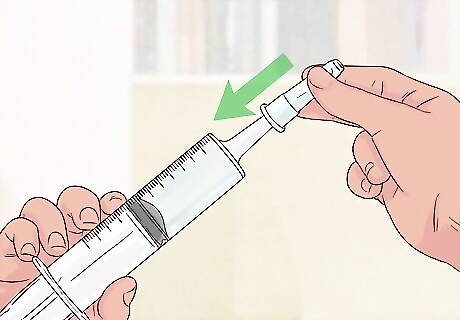
Cover the syringe and set it to the side. To make sure it stays sterile, place the tip cover included with your syringe onto the catheter tip. If a cover was not included, place the syringe back into its sterile packaging. Set it aside for later use.
Flushing the Catheter
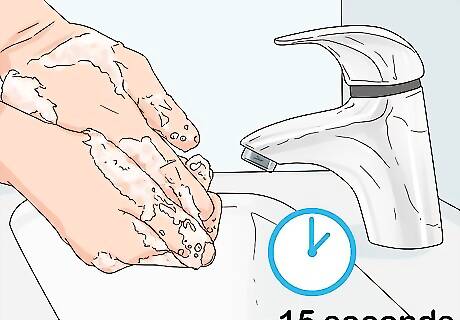
Clean your hands a second time. For safety, you should wash your hands again even if you already did so while preparing the syringe. Wash your hands with soap and warm water, scrubbing well for at least 15 seconds. Dry them with a clean paper towel when finished. If you are wearing latex gloves, replace them with a fresh pair.
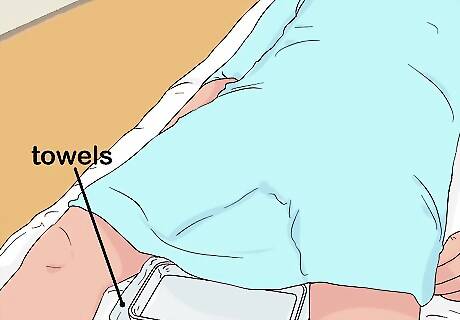
Place towels and a pan under the catheter. To absorb excess liquid and urine, place several towels beneath the connection site joining the catheter to the drainage tubing. Then, position a pan beneath the open end of the catheter connection. This basin will collect urine and other fluids that escape the catheter as you irrigate it.
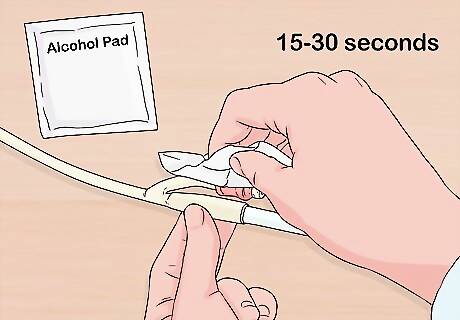
Clean the catheter. Scrub the connection site between the catheter and drainage tubing with an alcohol pad, cleaning the area for 15 to 30 seconds before continuing. Allow the area to air dry on its own. Do not dry it with towels, and do not attempt to speed up the drying process by blowing on the area with your breath or a fan.

Separate the catheter from the drainage tubing. Gently twist the catheter off the drainage tubing to disconnect the two pieces. Place the end of the drainage tubing on a clean towel. Position the catheter over the collection basin you just prepared, but do not let the open end of the catheter actually touch the basin. Make sure the basin is lower than the end of the catheter and the person's abdomen.

Remove excess urine from the catheter using an empty syringe. Place a sterile, empty syringe into the open end of the catheter that's over the basin. Gently pull the plunger back to check for excess urine. If you draw urine into the syringe, continue pulling to remove the urine currently inside the catheter. Remove as much urine as possible before continuing. Try to suction out any sediment or clots as you do this. Have the person wearing the catheter to sit in an upright position so more urine comes out. Dispose of urine in a toilet or other clean, sterile waste container.
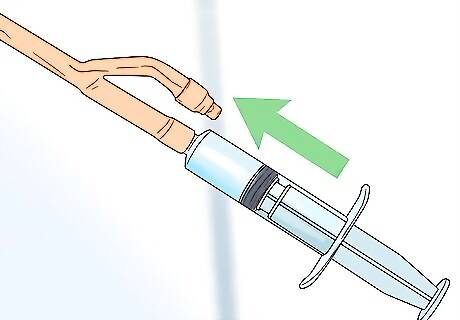
Switch to the saline syringe. Remove the empty syringe from the catheter and dispose of it. Then, grab the syringe filled with saline solution and, if necessary, remove the cap. Insert the saline-filled syringe into the catheter opening and twist the syringe until the connection feels secure. To keep it sterile, remember to avoid touching the end of the syringe.
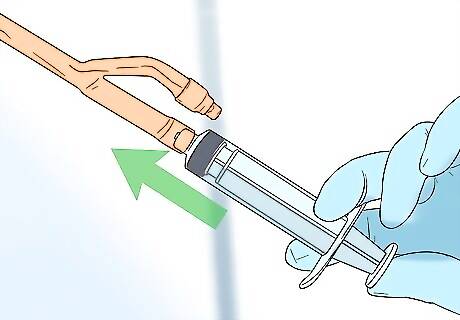
Push the saline into the catheter. Push the plunger down to insert all of the saline into the catheter. Stop if you feel any resistance. When finished, pull back on the syringe plunger to remove as much of the saline solution as you can. If you encounter resistance, stop and call a doctor for help, as they may need to change the catheter or use a different technique to irrigate it.

Clean the catheter connection site and drainage tubing. Scrub both the catheter connection site and drainage tubing with an alcohol wipe for about 15 seconds. Let them dry on their own, and do not attempt to speed up the process by drying them with towels or blowing on them with your mouth or a fan. Make sure to remove the drainage tubing cap before cleaning it.
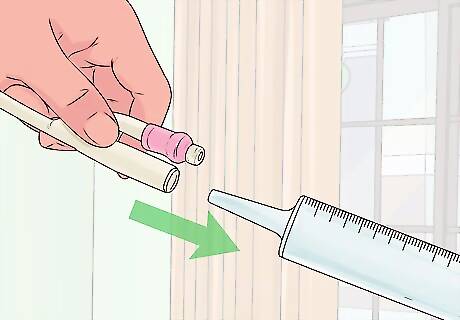
Remove the syringe and reinsert the tubing. To remove the syringe, pinch the end of the catheter while untwisting the syringe from the catheter cap. Then, insert the tubing back into the catheter. When everything is secure, discard the used syringe.
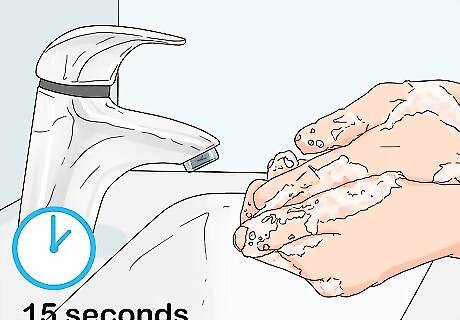
Wash your hands one more time. For safety, wash your hands with soap and warm water for 15 seconds, then dry them with paper towels. Though this may seem like overkill, it will protect you from any bacteria from the catheter and urine.
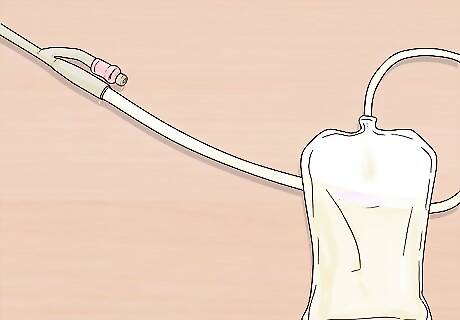
Make sure the urine is flowing properly. After irrigation, urine should flow from the catheter with ease. If urine has not started flowing after 15 minutes, repeat the flushing process. If the problem persists, call your doctor.



















Comments
0 comment